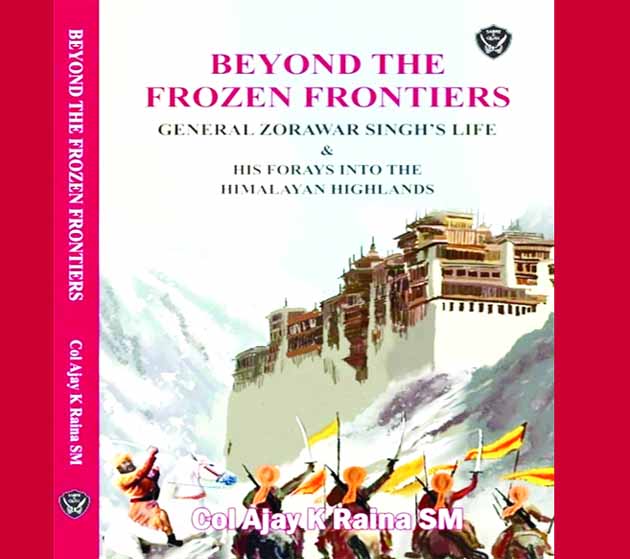Ansh Chowdhari
Name of Book : Beyond the frozen frontiers
Author: Col Ajay Raina
Pages: 262
Publisher: Sabre and Quill
Col Ajay Raina’s Beyond the Frozen Frontiers: General Zorawar Singh’s life & His Forays Into The Himalayan Highlands offers a unique and a comprehensive story about one of India’s most formidable military leaders . In this compelling biography, the author has delved deep not only into the life and exploits of General Zorawar Singh but has also painted a vivid scenery around his persona by inculcating other actors too who influenced or got influenced by him. It wouldn’t be an exaggeration to say that this book is just like a colourful painting that has sketched a vivid portrait of a man whose courageous exploits and strategic genius created a lofty benchmark in the Indian martial tradition.
Having around 262 pages and 20 chapters, Raina’s work is exhaustive in his examination of Zorawar Singh’s life, providing readers with the surrounding historical context, personal anecdotes, and military analysis. The book’s earlier section begins with a detailed account of Zorawar Singh’s early years, the controversy surrounding his birth year and his serendipitous meeting with his mentor-lord Maharaja Gulab Singh.
As the narrative unfolds and gets deeper, the author lays bare the conditions under which Zorawar Singh rose through the ranks of the Dogra military establishment while he carefully nurtured a great bond with his leader Gulab Singh, whom the latter had given a free run over his area of affairs. The author while quoting GC Smyth says that “while he was winning provinces and hoarding wealth for his patron, he exercised the most rigid self denial towards himself. He had never drawn pay from the time of his first interview with Rajah; he wore no clothes but those sent him by his master….” highlighting his exceptional leadership skills, tactical acumen, and unwavering commitment to the defense of his homeland. Right from establishing peace in the restive areas to quelling minor rebellions in Jammu, Zorawar established himself as a visionary military leader of the 19th century India.
One of the book’s greatest strengths lies in its elaborate depiction of Zorawar Singh’s military campaigns in those trans Himalayan regions. As already stated, here too, the attached maps supplement the reader’s reading experience and makes him virtually picture those pitch forked battles fought at those harsh altitudes. Being an army man himself, Raina has ably captured the minute details of those military campaigns. He mentions that “through his foresight and practical approach to the problems, he had created a tough, hardy band of men capable of handling some of the best fighting paraphernalia available at that point time, in the toughest rain in the subcontinent” , thus capturing the challenges faced by Zorawar Singh and his troops as they waged war against formidable adversaries. The most interesting chapter was “Into Tibet” that explains the gallant Dogras moving through the vast mountainous stretch of Western Tibet to capture this inhospitable territory because “of likely tribute and faith that General Zorawar had long nursed…”.
In addition to his military conduct,Col Raina also offers readers a glimpse into Zorawar Singh’s personal life, throwing light on his relationships and deep religious outlook. Through a nuanced and rational portrayal of Zorawar, the author has not leapt out of the bounds to create a legend around his figure. He, on the contrary, has said, that Zorawar, despite all his positives, had to grapple with innumerable challenges in his campaigns. This courageous attempt of the author, apart from being a fundamentally coalesced version of different sources related to the hero of the book, is an insightful peep into the personality of the hero and his motives.
Despite the painstaking research that has gone into writing this book, this work is not without its flaws. At times, the author has delved too deep into the contextual history, thus, affecting the flow and making it a bit difficult for readers situated outside of J&K to grasp those names and their relevance. Additionally, I felt that that there are some places where the author has used his understanding of the prevailing facts to make certain assumptions regarding some dates which may not be per se. However, it is pertinent to mention that these dates are already controversial.
Succinctly, it can be said that Col Raina’s biography of General Zorawar Singh stands as a monumental achievement in the field of military history, offering readers a comprehensive and engrossing account of one of India’s most legendary figures. Through his extended research, vivid story-telling, and insightful analysis, Raina brings Zorawar Singh’s remarkable story to life, ensuring that his legacy will continue to inspire generations to come. The language is simple and easy to understand. I recommend this book to every history lover who wants to explore the forces which enabled the Dogras to bring those trans Himalayan regions within the Indian fold. Col Raina rightly points out that had the circumstances and times been different , Napoleon would have been called as the Zorawar of the West and not the vice versa.
Trending Now
E-Paper


